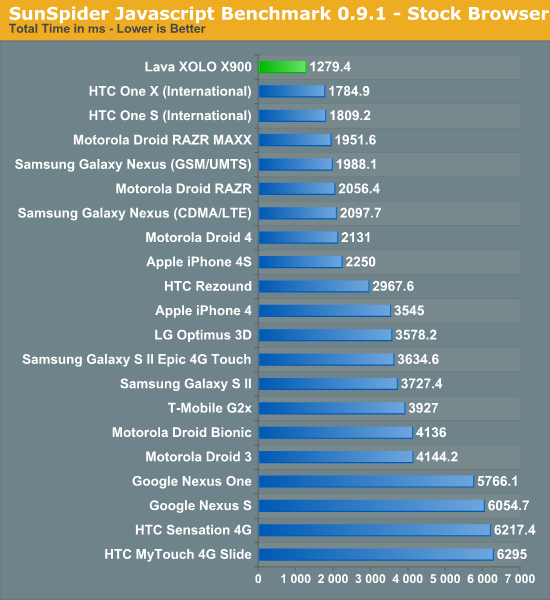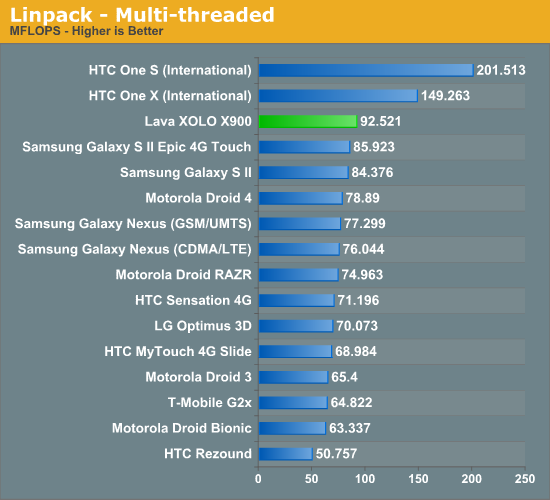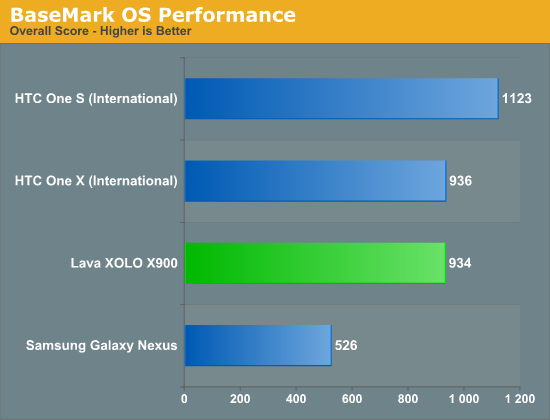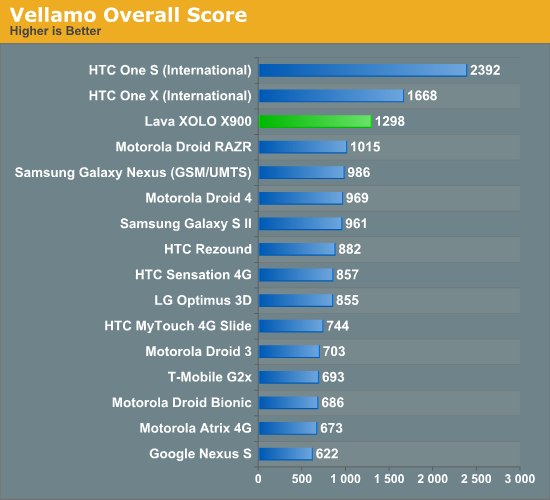Lava Xolo X900 Review - The First Intel Medfield Phone
by Brian Klug on April 25, 2012 6:00 AM ESTJavascript Performance
Although smartphones are clearly headed for a life beyond simple messaging, web browsing and phone duties, we are still lacking the tools to measure performance in areas other than a component of web page rendering. Measuring javascript performance is one component of the entire web page rendering process but it's the most mature in terms of something we can benchmark.
Sunspider is quite possibly the most well known of these javascript tests, and it also happens to be one that runs extremely well on Medfield:

The Lava phone is just a tad faster than the FFRD we tested at the beginning of the year, which may not sound like much but is positive given that Mike Bell was very confident that all Intel FFRD phones would deliver the same level of performance. The X900 ends up being the fastest smartphone we've ever tested here. Intel won't be able to claim that title in any other benchmark here today but it's an impressive feat for just now showing up to the game. It's also worth pointing out that Intel is able to do this well running on Gingerbread, while its closest competition are running on Ice Cream Sandwich with far improved JS performance built into the browser.
Why is Medfield so much faster here? It's tough to say, but likely a combination of reasons. Google's V8 engine has had a ton of optimization work done around x86 to begin with. By virtue of nearly every computing platform that runs a Google browser outside of Android being x86, it's natural that some of those optimizations are going to transition over into Android for x86 as well. That's actually a part of a much larger advantage Intel has should x86 take off in the smartphone space.
On a more technical hardware level, Intel claims its cache and memory interfaces are simply better than the competition here - which in turn results in a significant performance jump in Sunspider.
BrowserMark is another js benchmark in our suite, but here the advantage has been reduced to simply competitive with the fastest phones in our labs:

For a single Atom core running Gingerbread, Medfield does very well here - roughly equaling the performance of NVIDIA's Tegra 3 (HTC One X) and Qualcomm's Snapdragon S4 (HTC One S). It's quite possible that when running ICS Medfield will once again step ahead of the competition, but even if this is as good as it gets it's a good start. Keep in mind that we're looking at a 4 year old microprocessor architecture running on a n - 1 process from Intel.
Low Level FP Performance
Linpack isn't a great indication of smartphone performance, but it is a good test of the floating point capabilities of the CPUs in these SoCs. ARM has steadily been improving FP performance for the past few generations but we're going to see a big jump to Krait/A15. As most client smartphone workloads are integer based and those that are FP heavy end up relying on the GPU, an advantage here doesn't tell us much today (particularly because Linpack isn't running native code but rather atop Dalvik) other than how speedy the FPUs are:

Single threaded FP performance is very good on Medfield as you'd expect, but a bit lower than Qualcomm's Snapdragon S4. As Krait is a wider, out-of-order architecture with a fairly reasonable FPU the 13% advantage here isn't too surprising. Compared to anything A9 based however, Medfield is obviously quicker.
Linpack, like many scientific workloads, scales up to multiple cores quite nicely. If we spawn as many threads as there are logical cores (2 for Intel and Qualcomm, but 4 for NVIDIA's Tegra 3) we can see how Intel's single-core Atom fares in a multithreaded world:

There's roughly no change in Medfield's performance here, which will be an issue for any compute heavy, very threaded application. Luckily for Intel, not many of these types of applications exist on smartphones today, but it is a limitation of this first generation Medfield. Hyper Threading is a great way to increase CPU utilization power efficiently, but for some workloads there's no replacement for more cores. Snapdragon S4 does extremely well here in the HTC One S by being a combination of two cores and having a much faster FPU.
BaseMark OS
Rightware's BaseMark OS is a general purpose benchmark designed to better simulate overall Android performance. It includes a heavily threaded benchmark, file IO tests, and compression/decompression tasks that all contribute to its overall score. We only have results from the HTC One S (Snapdragon S4), One X (Tegra 3), Galaxy Nexus (OMAP 4) and the Lava phone (Medfield) here:

At least in BaseMark OS, Intel's performance is distinctly modern although not at the head of the class. Differences in performance here extend beyond the SoC and are obviously influenced by things like NAND selection as well as the OS on the device. For many of these benchmarks I'm very curious to see how they change with the arrival of Ice Cream Sandwich.
Vellamo
Vellamo is a Qualcomm developed benchmark that focuses primarily on browser performance, both in rendering and UI speed. The results are heavily influenced by the browser used on the device being tested. As a whole Vellamo isn't always indicative of whether or not you're going to get a smooth browsing experience, but it's another datapoint that captures more than just javascript performance. The Qualcomm-developed nature of the benchmark is always cause for concern, but even if you exclude the Snapdragon results the benchmark can be useful:

Once again we have a good showing from Intel. The X900 and its Medfield soul aren't the fastest, but Intel's first smartphone is in the top three and faster than almost everything that came before it. Much of the advantage here actually comes from the Google V8 benchmark, another js test, which we've already established Intel can do quite well in.
Flash Rendering Performance
These days nearly all high-end smartphones (I refuse to call them superphones) can render Flash smoothly. Thankfully Intel's platform is no exception as the X900 delivers a competitive showing in our Flash benchmark:











106 Comments
View All Comments
Spunjji - Thursday, April 26, 2012 - link
...so, suddenly it becomes more than mere opinion when you say the opposite? You have to admit you're on shaky ground with that line of argument."Could benefit from being thinner" isn't quite the same as "too thick". I suspect you mean the former?
UltraTech79 - Thursday, April 26, 2012 - link
Its not an opinion when its true. Phones should stay below 1CM thickness, and even 1CM is pretty beefy. Many people will not consider it due to this and not having a real huge advantage anywhere else.When all else is roughly the same, comfort and aesthetics decide a buy.
phoenix_rizzen - Friday, April 27, 2012 - link
1 cm is *way* too thin for anyone with "normal"-sized hands.Compare the aesthetics of holding/using a cordless phone, an office phone, a corded-phone, basically any phone handset other than a cell phone to a cell phone. Which feels more comfortable in your hand to speak into for more than 3 seconds? The one that fits nicely in the palm of your hand, that nicely curves with the natural lines of your hand (aka everything other than a cell)? Or the one with sharp edges, barely 1 cm thick, that requires you to use the muscles in the sides of your hands to grip, leading to cramping if you actually try to, you know, talk, on the phone?
Today's cell phones are too thin, and battery life is suffering for it.
fm123 - Friday, April 27, 2012 - link
Definitely an opinion. If someone wants a keyboard it's going to be over 1 cm. There are people that put their phone in cases and the result is way over 1 cm. The Otterbox Defender is somewhat popular, and the phone becomes almost 3/4 inch thick.FrederickL - Thursday, April 26, 2012 - link
On the general issue of "phone-thinness" rather than this phone in particular no doubt the same people who want the mobile equivalent of an anorexic catwalk model will then start howling about the battery life in their super-thin phone where there is scarcely room for a battery at all, let alone one with decent capacity. Perhaps we should be discussing the fact that some customers' contradictory "want my cake and eat it" demands indicate that the topic should be that some of the customers are too thick rather than the phones.
mrtanner70 - Wednesday, April 25, 2012 - link
I find the "a bigger battery is all we need" argument rather weird in the context of the thickness. It's not like Intel has not already considered this trade off. It's lighter than I expected though.The trouble with reviews like this (and this is not a criticism) is that SOC price is not considered, nor that fact that the mobile industry really would rather Intel, and its monopolistic/margin desires, stay away. Benchmarks (unless paradigm breaking) are not going to change that.
So far, I do not believe Intel has a single true design win, they paid for them all.
menting - Wednesday, April 25, 2012 - link
profit margins for ARM and Intel as a whole company, if this page can be believed, are similarhttp://ycharts.com/companies/ARMH/profit_margin#se...
menting - Wednesday, April 25, 2012 - link
we dont know what that phone will cost in the US, but for a phone that costs $420 with that performance???? ARM will be pissing in their pants right now if it had the performance of A15 on that phone.duploxxx - Wednesday, April 25, 2012 - link
Knowing that it can't keep up against already existing platforms introduced a while ago it is a failure. Don't see any reason why to buy this mobile phone, it doesn't have any added value against any other major competitor.not on price/power/performance.
so it is doomed before it is even released.
lets see what the tablet brings, but it doesn't look good at all. It all starts with the Atom which has never proven to be a good arch.....
A5 - Wednesday, April 25, 2012 - link
For a first attempt (Moorestown was always going to fail, so I don't count it :P) it really isn't that bad. It pretty handily beats the A9-class SoCs from last year while being somewhat competitive with the S4 running ICS. I'm curious to see if the Medfield ICS build gets better performance.I don't know how much Medfield phones will cost, but if it comes over here as a $420 off-contract device, that places it pretty firmly in the mid-range, where it would certainly be pretty competitive with the A9 devices that will be down there.